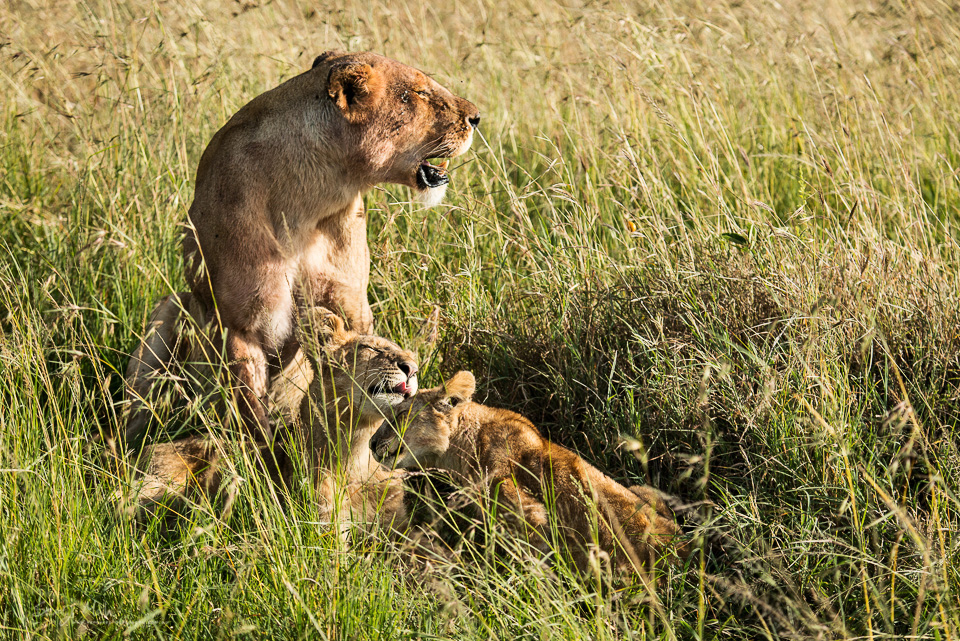Safari Photography – Part 2: Taking your safari photography to the next level
Photographing wildlife while on a safari is both challenging and rewarding. Challenging because there’s a whole set of elements outside of your control and rewarding when you know you have nailed that shot.
In the previous article (Part 1) we looked at the equipment and preparation side of things. In this article, we will look at the more technical and creative aspects of photographing wildlife in its natural environment.
Environmental Conditions
Animals in their natural habitat can make startling and fascinating photographic subjects. However, you may find that the environment in which you find them may make photographing them an uphill battle. In bush and savannah settings, for example, grass, scrub and trees can partially obscure the animals lurking in them.
While on safari in the Masai Mara in Kenya, we came across a pride of lions, including several cubs in the tall grass eating the remains of a warthog kill. The dry grass made focusing on the lions a challenge as the camera’s autofocus would as likely lock onto blades of grass as on the lions behind them. At other instances, we would find giraffe families feeding in a small grove and moving in and out the trees.

Here are some tips to help you work with environmental conditions that might otherwise hamper your wildlife photography:
- Use a single focus point instead of having all your focus points activated. Grass, branches, trees and scrub all present high contrast objects that may draw the attention of your camera’s autofocus. To make sure that your camera does not inadvertently focus on trees or grass instead of the animal, switch to single point autofocus and set this to the focus point that will best help you lock on the animal and compose for the scene.
- If your camera has back button focus, use this instead of the half-shutter focus. Back button focus separates focusing from tripping the shutter. By using the back button focus technique, you can give attention to obtaining focus on the animal and pressing the shutter button when you want to take a picture. Once you have locked focus, you can press the shutter button multiple times while maintaining focus on the animal, instead of having to re-focus each time you want to take a photo.
- Shoot in Drive or Continuous Shooting Mode so that you don’t miss a moment once you have locked focus on the animal. This is particularly important if the animal is doing something interesting eg. playing, grooming, feeding.
Photographing Moving Animals
Animals in action make for great photographs – especially when shot with a fast movement-freezing shutter speed. However, keeping your focus locked on the moving animal can pose a challenge. Try these tips when photographing animals in action:
- Set you camera to continuous autofocus (sometimes called AF tracking or AI-Serv on Canon DSLRs). In continuous autofocus mode, your camera’s autofocus will continuously adjust to keep the subject focused on the active focus point. Move your camera and adjust your field of view (using your zoom) to keep the active focus point on the animal as you focus and shoot. Back button focus works best when you’re shooting this way as you can use the back button to keep focus on the animal while separately grabbing shots with the shutter button.
- If your camera has Zone Autofocus or Dynamic Autofocus, turn this on. Zone/Dynamic Autofocus will activate the focus point adjacent to your selected point if you don’t happen to be fast enough to keep your selected point on the moving animal. It can help you maintain focus on the animal.
- Shoot in Drive/Continuous Shooting Mode to grab as many frames as you can of the animal in motion.
- Shoot from a higher angle. This will take you above the pesky disarray of grass and let you see and focus on the animal. Many safari vans/jeeps have a pop up top allowing passengers to stand and shoot from above.
- Make sure your shutter speed is fast enough to freeze the moving subject. Birds in flight need to be photographed at around 1/2000 of a second in order to freeze the motion of their wings. Running antelopes may require a shutter speed of around 1/1000 to catch them on the run. If needed, increase your ISO to make your camera more receptive to light so that you can attain the desired fast shutter speeds.

Telling the Story
Photographing wildlife is more than just taking images of animal specimens in their natural environment. One of the drawcards of embarking on a wildlife safari is to view these creatures as they would behave in their natural environment. Use your camera to document their behaviour – the way they interact with each other, the relationships that exist between animals and their young. These images are more emotionally laden because they tell a story and reveal aspects of the animal to which many of us can relate.
To best tell a story when photographing wildlife:
- Don’t rush to shoot straight away. Take a moment or two to observe the animals. Grab a few frames initially if you wish, but then spend some time watching and studying them (imagine that you can hear Sir David Attenborough’s voice in your ear describing the behaviour of the animals you see). Every story needs to have its main character and by watching and waiting, you can identify the lead character in your wildlife story. Perhaps it’s the mother antelope suckling her baby, or lion cubs grooming each other. Once you have identified your “main character”, start photographing.
- Shoot tight and shoot wide. Framing tight can help you create animal portraits, where the viewer’s attention is drawn immediately to the animal’s gaze or something unique about its visage. When shooting tight, treat the shoot as if you’re photographing portraiture – compose for the animal’s face and throw the background into soft focus. Framing wide can show the animal main character’s role within the context of the herd or pride. For example, many African antelopes employ one or more sentries to keep an eye out for potential predators. Shooting to include the sentry animal on watch while surrounded by the rest of the herd conveys this story.
- Look for detail. Your story doesn’t always have to be a saga about the pride or herd; it could be an observation about a part of an animal – the way elephants entwine their trunks as a way of touching/connecting with each other, or the way a lion cub peeks out from under its mother’s feet.

Get Creative
You don’t always have to follow the rules of “good photography” when you’re photographing wildlife. It’s you adventure and you should feel free to create visuals that stimulate and excite you as a photographer! Try these:
- Look for visuals that other photographers may miss, whether it’s a detail shot of a part of an animal (the way its tail curls) or its markings (zebra stripes, giraffe patterns).
- Shoot at a slower shutter speed and pan you camera while you’re photographing moving/running animals. (Hint: to best use this technique, make sure you set your focus to continuous autofocus and have your continuous shooting/drive mode turned on). Experiment with shutter speeds around 1/15 or 1/5 of a second for fast moving animals.

Recognise and Use Directional Light
The best light is directional light. It helps shape the subject through the use of shadow, or create separation between subject and background. Portrait and landscape photographers recognise the value and beauty of directional light and you should too when photographing wildlife.
In the wilderness, your primary light will be from the sun. On sunny days, it will be a clear, hard light. On overcast days, it will be more diffused and softer. (Note: “Hard” and “Soft” light describes the transition of light to shadow; hard light has a clean-cut edge between light and shadow; soft light has a more diffused, feathered edge where the light softly graduates to shadow).
- Side lighting has the effect of giving your animal subject three-dimensional form. In a two dimensional medium such as a photograph, its important to create the illusion of form and depth and side lighting can help you achieve this. To obtain side lighting, simply shoot with the light source (sun) to your left or right.
- Rim lighting creates a “halo” around the animal and is created when the light source comes from somewhere behind the subject. The best rim light can be found at the golden hours of early morning and late afternoon/evening. It helps outline the animal and separate it from the background.
- Diffused light can occur on overcast days or at times of the day when the sun has yet to rise above the horizon. The light is particularly soft and atmospheric, with soft, almost pastel colours. Shooting in this light creates moody images. You’ll need to shoot at mid to high ISO ranges to compensate for the lower light, but you will be rewarded with softer images which are perfect for animal portraits.
One of the best experiences you will have on safari is that of actually seeing animals in their natural habitat. Don’t get too trigger-happy with your camera that you forget to take some time to realise and reflect on this. Your photographs will show others what you have seen, but make sure you experience the moment so that you will remember it for a long time.
[nggallery id=58]

Johannes
16/06/2014 at 9:58 amHaha, looks like there’s a little duck sitting on the head of the bull at image 24.
sengmah
20/06/2014 at 8:18 amJohannes – there is indeed! It’s called an “oxpecker” and they feed off the mites and insects that reside on the hide of the cape buffalo!
Johannes
20/06/2014 at 1:54 pmCool, and I thought I was making it up 🙂
Graham
04/07/2014 at 8:31 amJust reviewing for pointers, off again tomorrow can’t wait! Thanks Seng, some great shots.